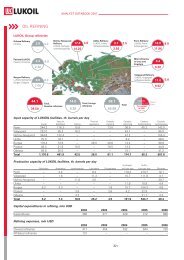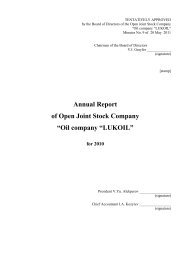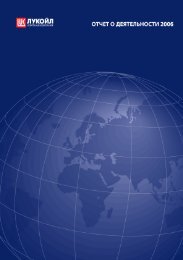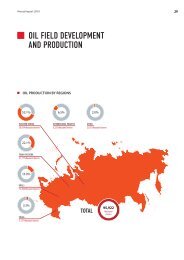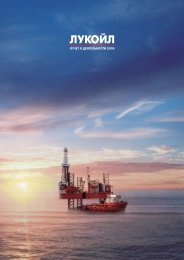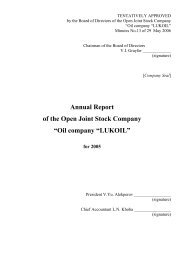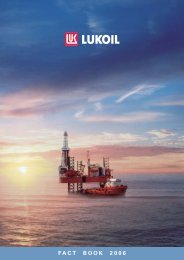ANNUAL REPORT 2005 - Lukoil
ANNUAL REPORT 2005 - Lukoil
ANNUAL REPORT 2005 - Lukoil
Create successful ePaper yourself
Turn your PDF publications into a flip-book with our unique Google optimized e-Paper software.
THE CASPIAN SEA<br />
The Caspian littoral states (Russia, Azerbaijan, Iran, Kazakhstan and Turkmenistan) are gradually<br />
resolving issues connected with the legal status of the Caspian and rights to use of its resources.<br />
Although it has not yet been possible to reach universal agreement, major steps towards such<br />
agreement have been taken. On the basis of bilateral agreements (Russia–Azerbaijan and Russia—<br />
Kazakhstan) and a trilateral agreement (Russia–Azerbaijan–Kazakhstan in May 2003) the northern<br />
part of the Caspian Sea, which occupies 64% of its total area and where the biggest hydrocarbon<br />
fields and the main international projects are located, was divided into three parts. As a result<br />
Kazakhstan took 27% of the total area of the Caspian Sea, Russia took 19% and Azerbaijan took<br />
18%. A further step was taken in January <strong>2005</strong> when the Presidents of Russia and Kazakhstan<br />
signed an agreement on the Russian–Kazakh state border, finalizing agreement on the demarcation<br />
line between the states in land and sea parts of the Caspian region.<br />
LUKOIL IN THE CASPIAN REGION<br />
LUKOIL is carrying out work in the Russian sector of the Caspian Sea as well as in the Kazakh and Azerbaijani<br />
sectors. In the Russian sector, LUKOIL is working independently at the North-East, North, Central-Caspian<br />
and Yalama-Samursky license areas. The Company is also working jointly with Gazprom and KazMunaiGaz<br />
at the Central area (LUKOIL has 25% interest in the project, Gazprom also has 25%, and<br />
KazMunaiGaz has 50% interest). LUKOIL is working with Gazprom and YUKOS at the North-Caspian area.<br />
The large amounts of time, effort and money which LUKOIL has invested in development of its resource<br />
base in the Northern Caspian have been rewarded. Geological exploration work carried out by<br />
the Group in the Russian sector of the Sea in 1995–2004 led to discovery of five large fields: Khvalynskoye<br />
(2000); Yu. Korchagin (2000); 170th Kilometer (2001); Rakushechnoye (2001) and Sarmatskoye<br />
(2002). Use of the latest technologies has enabled unprecedented levels of exploration efficiency by<br />
Russian standards: efficiency of exploration drilling has exceeded 15,000 tonnes of reference fuel per<br />
meter drilled (12 times higher than the Company average), and the success rate of prospecting and<br />
exploration drilling has been 100%, i.e. each field was discovered by the first prospecting well, which<br />
was drilled. At the same time the cost of one reference tonne reserve addition was more than ten times<br />
lower than that of major international oil companies.<br />
The history of LUKOIL success in the Northern Caspian<br />
was continued in November <strong>2005</strong>, when the Company<br />
discovered a new oil and gas condensate field –<br />
the V. Filanovsky field. Provisional assessments suggest<br />
that the field is the biggest in the region. The discovery<br />
well gave flows of light, water-free oil at a daily<br />
rate of 6,400 barrels, which is unusually high for Russia<br />
and comparable with rates in the Middle East. Probable<br />
and possible reserves at the new field are estimated<br />
at 600 million barrels of oil and 985 trillion cubic<br />
feet of gas. These reserves will be upgraded to 'proved'<br />
category after supplementary exploration, preparation<br />
and confirmation of project documents for development<br />
and construction of the field.<br />
LUKOIL 3P Reserves Structure<br />
in the Northern Caspian, as of January 1, 2006<br />
Sarmatskoye 14.7% V. Filanovsky 18.9%<br />
Rakushechnoye 15.1%<br />
Yu. Korchagin 14.2%<br />
170 th Kilometer 4.4%<br />
Khvalynskoye 32.7%<br />
93







